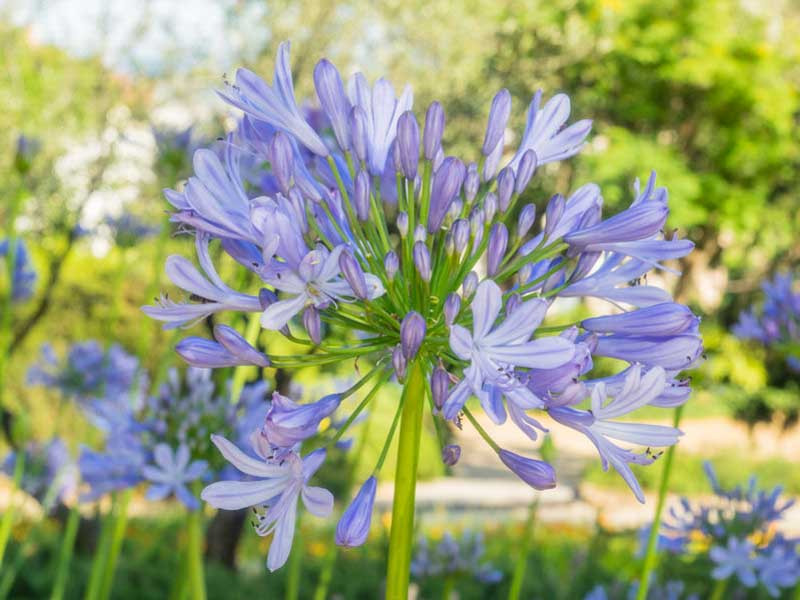Agapanthus Growing Problems: Soil, Sunlight, and Watering
Agapanthus Growing Problems: Soil, Sunlight, and Watering
Blog Article
Mastering the Art of Agapanthus Treatment: Necessary Steps for Healthy Development and Vibrant Flowers
In the realm of horticulture, the cultivation of agapanthus stands as a satisfying venture for those who seek to nurture these elegant blooming plants. With their striking blooms and graceful vegetation, agapanthus has actually caught the focus of garden enthusiasts worldwide. Nevertheless, accomplishing ideal development and lively blooms calls for a nuanced strategy that includes various crucial steps. From choosing the best range to mastering trimming strategies, the trip towards cultivating flourishing agapanthus plants is diverse and holds the essential to opening the full possibility of these botanical gems.

Picking the Right Agapanthus Selection

When picking the best Agapanthus selection for your yard, think about aspects such as environment suitability, blossom color, and development practice. Agapanthus, typically called Lily of the Nile or African lily, is available in a variety of shades varying from tones of purple and blue to white. Select a blossom color that complements your existing garden palette to create an unified landscape. Additionally, consider the climate in your area to guarantee the Agapanthus range you choose can thrive in your particular conditions. Some selections are much more tolerant of cold temperatures, while others choose warmer climates. Understanding the development practice of different Agapanthus ranges is essential for correct placement within your yard. Some varieties have a clumping development routine, perfect for containers or borders, while others have an even more spreading nature, ideal for ground cover or mass plantings. By meticulously examining these elements, you can choose the excellent Agapanthus variety to enhance the charm of your garden.
Suitable Planting Problems
Taking into consideration the ideal environmental requirements is crucial for effective Agapanthus farming. Agapanthus plants are sensitive to cold temperatures and must be protected from frost throughout winter months.
To ensure healthy growth and dynamic blossoms, plant Agapanthus light bulbs at a depth of about 2-4 inches and space them 8-12 inches apart. Mulching around the base of the plants assists preserve wetness and suppresses weed development.
Watering and Fertilizing Tips
Keeping appropriate dampness degrees and providing important nutrients are essential components in the treatment program for Agapanthus plants. It is essential to strike a balance when it comes to watering Agapanthus. If overwatered, these plants like constantly moist dirt but are prone to root rot. During the expanding period, water deeply when a week, making certain the dirt is well-draining to protect against waterlogging. In hotter climates or during durations of drought, even more constant watering might be essential to keep the soil equally wet. Nevertheless, reduce watering in the winter to avoid water logged conditions.
Feeding Agapanthus is vital for advertising healthy growth and prolific blooms. Use a well balanced plant food, such as a 10-10-10 formula, in the early spring as new development emerges. By complying with these watering and feeding ideas, you can ensure your Agapanthus plants flourish and generate vivid, basics durable flowers.
Trimming Strategies for Agapanthus
Trimming Agapanthus plants at the ideal times and with appropriate strategies is critical for keeping their wellness and promoting optimum growth and flowering. The perfect time to prune Agapanthus is in late winter season or very early springtime prior to brand-new growth emerges.
Deadheading spent flowers can additionally reroute the plant's energy right into creating even more blooms rather than setting seeds. If you want to accumulate seeds for propagation, leave some blossoms to completely dry and mature on the plant.
Keep in mind to make use of tidy, sharp devices to make exact cuts and reduce the danger of introducing illness. Agapanthus. Routine trimming will aid keep your Agapanthus looking healthy and neat while making certain a bountiful screen of gorgeous flowers
Managing Typical Insects and Conditions
After making certain appropriate pruning techniques for Agapanthus, it is essential to deal with typical parasites and conditions that can influence the health and vitality of these plants. One typical bug that influences Agapanthus is the Agapanthus gall midget.
In addition, Agapanthus plants can endure from root rot if they are planted in improperly draining dirt. By being alert and taking prompt activity against illness and bugs, you can aid your Agapanthus plants prosper and create vivid blossoms. Agapanthus.

Conclusion
Finally, mastering the art of agapanthus treatment includes selecting the ideal learn the facts here now selection, giving ideal planting conditions, correct watering and feeding, proper trimming methods, and dealing with common parasites and illness. By complying with these necessary steps, you can make sure healthy growth and dynamic blooms for your agapanthus plants. Keep in mind to regularly monitor and preserve your plants to advertise their general wellness and durability.
To make sure healthy growth and dynamic flowers, plant Agapanthus bulbs at a deepness of regarding 2-4 inches and area them 8-12 inches apart. By adhering to these watering and fertilizing suggestions, you can guarantee your Agapanthus plants thrive and create vivid, long-lasting flowers.
One common pest that affects Agapanthus is the Agapanthus gall midge. Additionally, Agapanthus plants can suffer from root rot if they are grown in badly draining soil. By adhering to these crucial actions, you can guarantee healthy growth and lively blooms i thought about this for your agapanthus plants.
Report this page